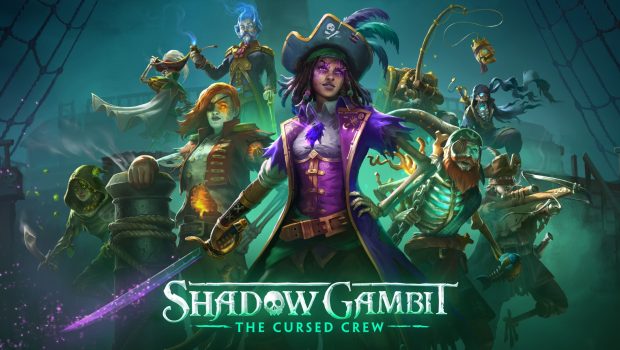Shadow Gambit: The Cursed Crew PC Review – Ship Shape … @MimimiProd
Summary: Exceptional stealth-based strategy gameplay with fun characters, colourful visuals and an emphasis on playing your way in your own time.
4.6
Aye-ron Maiden
Shadow Gambit: The Cursed Crew is one of those games where the “just one more time” dilemma is apparent – and in a very good way. With fun stealth-based strategy gameplay centered around using a variety of creative options and clever time manipulation, it’s easy to get lost in not only what you can do, but what you could have done.
Is it better to shoot a ghostly crewmate across the map to distract the guards, or snipe them from afar? Is it more fun to possess a zealot to swagger past them in the open? Is it better to go non-lethal for more badges, or indulge in the spectral swashbuckling fantasy?
The great thing is developer Mimimi Games, known for Shadow Tactics and Desperados III, caters to many different types of playstyles in their latest stealth strategy sandbox game, with no one option is the ‘right’ one (well, some are cooler than others) for an in-arrrr-guably fun experience.
Shadow Gambit: The Cursed Crew takes place in an alternate history setting of the Golden Age of Piracy, where dead pirates and scallywags sail the high seas as cursed corpses. The same voodoo that keeps these pirates alive also bestows them with great and terrifying powers, and to combat this, an ultra-religious zealot group called the Inquisition of the Burning Maiden hunts the Cursed down using The Maiden’s Fire, itself a source of unique and frightening supernatural powers. As protagonist and newcomer Affia Manicato, players take the helm of the legendary pirate ghost ship the Red Marley, set sail to revive its motley crew of Cursed one-by-one using the mysterious Black Pearl artifacts, and take on the Inquisition, who are after the mysterious treasure of the Red Marley’s previous Captain, Mordechai. The main plot sees players travel all across the Lost Carribean, supported by several unique subplots involving each crew member.
Knowing my usual gaming preferences lean toward grimdark stories, I was pleasantly surprised with just how fast Shadow Gambit’s mystical backdrop of the Lost Carribean captured my interest. The story is more swashbuckling whimsy and historical fantasy than developer Mimimi Games’ previous titles, Shadow Tactics and Desperados III, yet it still carries a serious plot that moves at a fast pace and contains interesting narrative developments, fun character interactions and lore. And let’s face it, there’s not enough games in a Caribbean-placed, pirate setting!
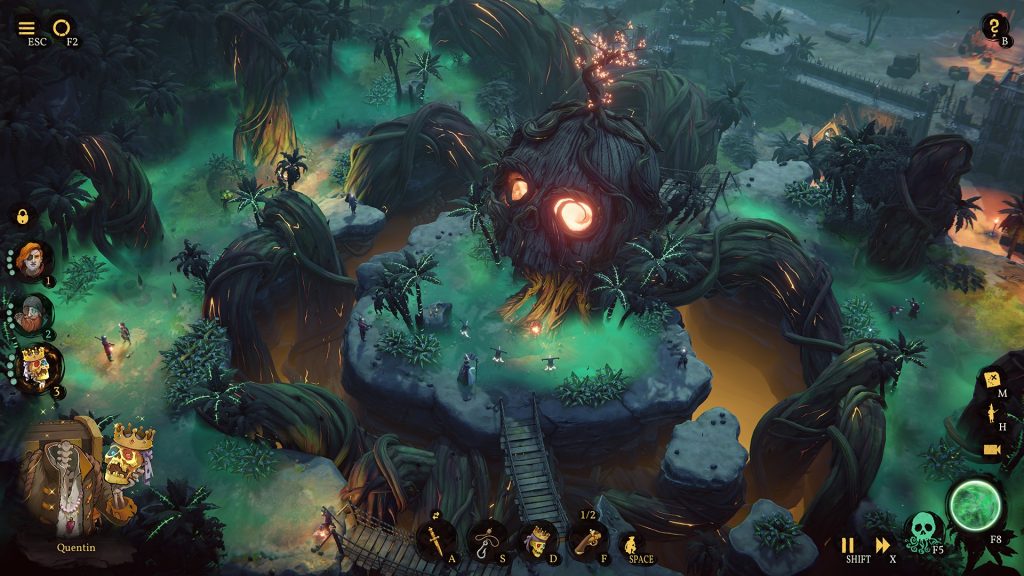
Being the third entry in the real-time tactics and puzzle genre that Mimimi Games has made its own in recent years, Shadow Gambit continues to offer a very unique gameplay experience. This is a squad-based strategy game played in real-time with pause (RTwP) from an isometric perspective, where you must issue orders to up to three characters as they navigate a series of open-ended, sandbox-structured levels with hand-crafted enemy encounters, puzzles, pathways and secrets. Taking place across several big and small islands in the fictional archipelago called the Timeless Shores, each map is multi-layered with several objectives which you must complete to proceed, and your overall performance is graded at the end of each level with earnable badges and recorded results. You’ll also have the chance to return to each island to tackle different missions across a 30+ hour playthrough (which is extended further if you choose to do all side missions and character-based quests, called crew-tales).
You have free reign to scope the map, plot your path and plan for such obstacles in the manner you choose; however, patrolling members of the Inquisition are highly-alert and require trickery and timing to evade or eliminate, and they can quickly overwhelm your team by sounding the alarm if you get spotted or play too aggressively, meaning smart and stealthy play is heavily incentivised. Thankfully, each guard’s cone of vision is clearly visualised, as are the many environmental objects which can be used to your advantage, such as light sources, gun boxes, climbable vines and ladders, and carefully hidden caves and rooms.
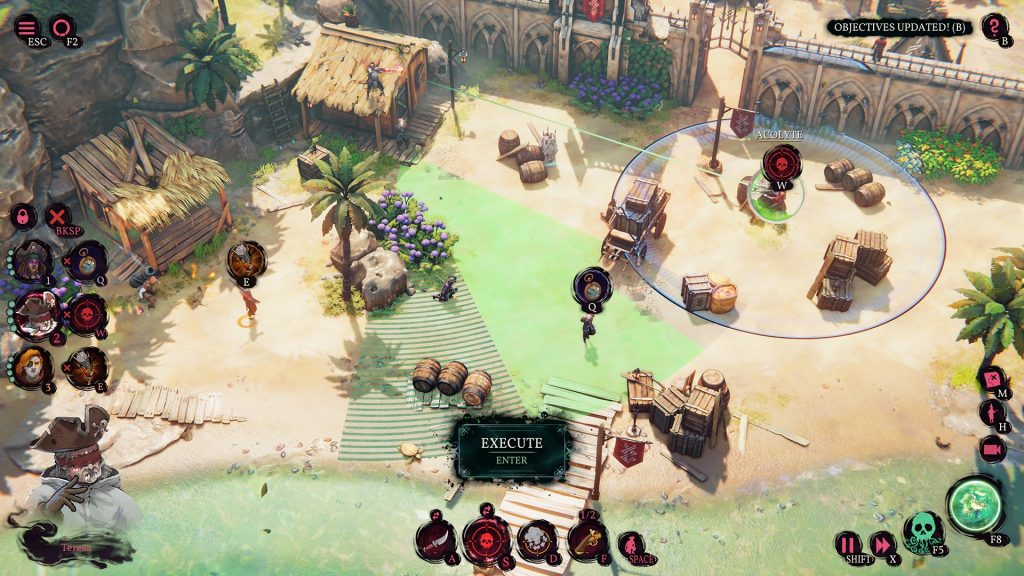
The Red Marley’s crew, a colourful cast of eccentric and scurvy troublemakers, come in handy for the tasks ahead. Brought to life by striking character portraits and models that embody the fun and fantastic tone that the game delivers in spades, each of the nine mystic mateys have different powers which form the crux of the gameplay and provide many unique options (including lethal and non-lethal) to experiment with and find which approach suits your tastes. Some are great infiltrators who can distract enemies and evade tight patrols, others are great at picking off foes, some encourage very creative strategies, and all are balanced by certain limitations – for example, certain members can swim and climb vines, while others can’t but may make up for it with their arsenal (one crew member, Gaelle, literally carries around a cannon). All of them can be trialed and conversed with in the game’s main hub area, the Red Marley itself (which also is sentient), before you deploy.
My personal favourites were Toya of Iga, the proud Japanese cook who makes for a deadly assassin thanks to a teleport move which lets you mark nearby foes before dispatching them with a click; Pinkus van Presswald, the fancy out-of-place nobleman who can take over guards to walk among enemies in plain sight, distracting them with hilariously well-mannered chatter; and Affia herself, a classic all-rounder who reminds me of Dishonored’s Corvo Attano, able to slow down time and instantly ‘blink’ between spaces. Chaining all of their movements and unique abilities together, in sync, proved to be both endlessly fun and satisfying to pull off successfully. Not to mention all of their funny and varied buccaneer back-and-forth banter during missions.
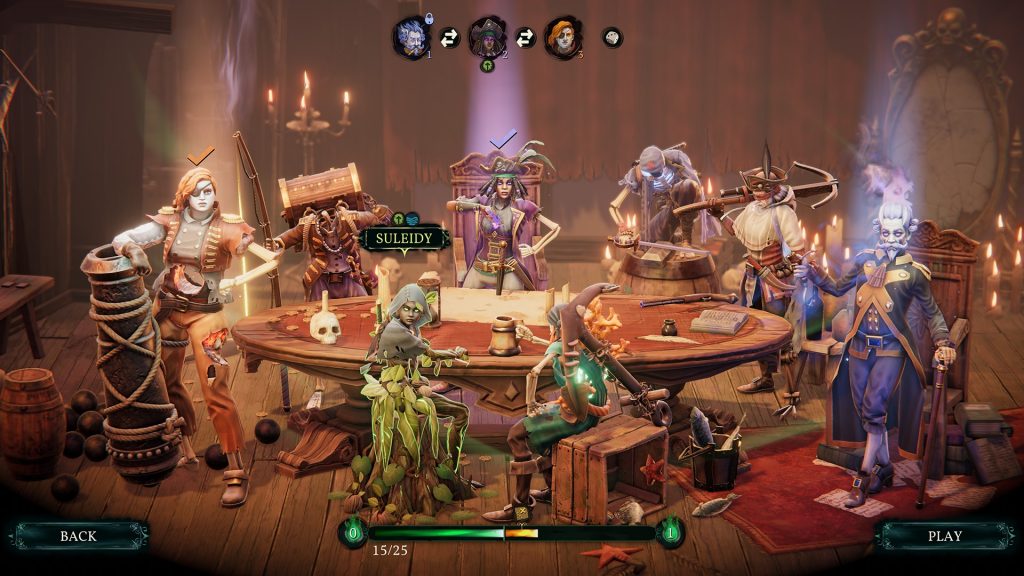
Of course, your crew’s extraordinary abilities wouldn’t be as fun to leverage without a competent enemy, and the Inquisition has some tricks up their sleeves as well. In addition to the usual grunts (Acolytes) are supernaturally-powered Inquisitors who can’t be dispatched by basic means. Kindred, for example, are pairs of monks that are connected via the mind and if both aren’t taken out at the same time, they can revive the other and alarm the whole map. Commisarrius, meanwhile, are higher-ranking guards who can’t be distracted as easily, which I found out the hard way when my Pinkus was unable to mind control or sweet-talk them long enough for my squad to sneak by. Thankfully, your crew’s powers can also be upgraded as you acquire Vigor by completing missions with them; upgrading Pinkus’s Peruse Mind ability down-the-line let me dispatch Commisarrius guards and coordinate my team much easier.
Death is never really the end in video games when you have quick-loading in your arsenal. But it can feel a little cheap or tedious, at times, to reload a save in order to get the best outcome. For stealth-based, real-time tactics games, though, quick-loading is in the formula, and Shadow Gambit: The Cursed Crew goes one step further to make it a core part of both its gameplay and story. With just one button, you can save a point in time and return to it, to try again instantly. The funny thing about the deeper quick-loading integration is it doesn’t make the game feel too easy at all, as I found it incredibly enjoyable (and funny) to watch as my plans went awry, such as teleporting Affia toward a sniper in a lighthouse at the exact only possible second she could to remain unseen, only for my Toya to make an unexpected ruckus while swimming and alert everyone… and my last quick-save being half-an-hour prior. Seeing all the potential variables I missed, and all the other options I could leverage had I chosen another crew member first is mind-boggling, but also very impressive and rewarding once I returned with a working strategy.
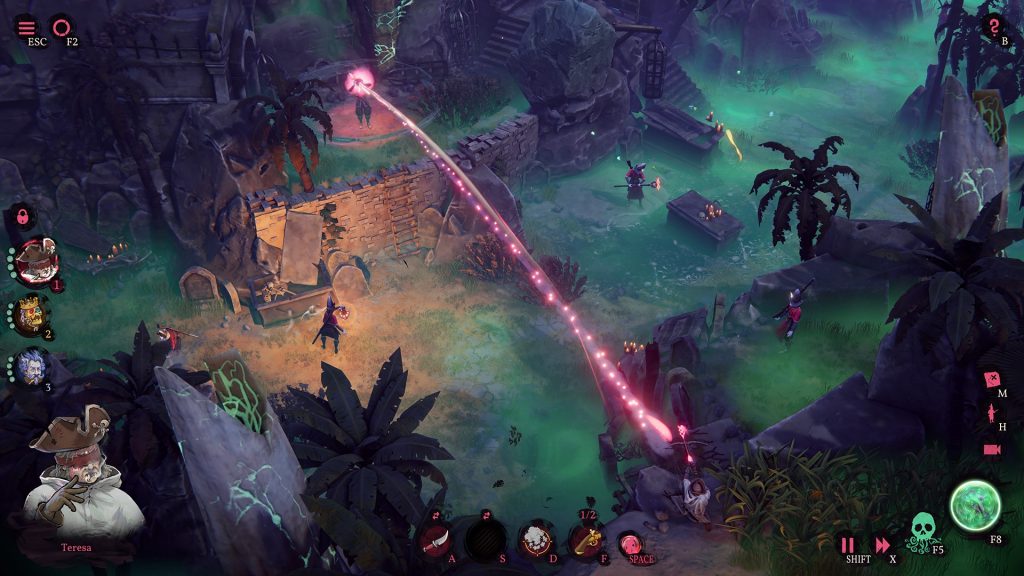
For anyone worrying about complexity or difficulty, the game ships with 4 difficulty levels and five customizable sliders (number of guards, player health, ammo, detection speed and number of quick-loads to tweak the game’s challenge and accessibility the exact way you prefer. Customization also extends to the game’s visuals, with options including a colorblind mode and viewcone quality (the guards’ visualised sight radius) helping provide accessibility to more players, as well as the usual options for texture, shadow, lighting, resolution and aliasing quality.
Playing on an RTX 3060 ti and Ryzen 5 3600, I was able to play Shadow Gambit with max settings at 120fps easily. This is a graphically impressive game elevated by very colourful character contrasts and highly detailed world environments, with character artwork that pops with personality during main story cutscenes and dialogue interactions. The audio work, too, is fun and in spirit with the mystical pirate setting, with jolly and somber tunes and exaggerated voice acting that really sells the ghost ship fantasy.
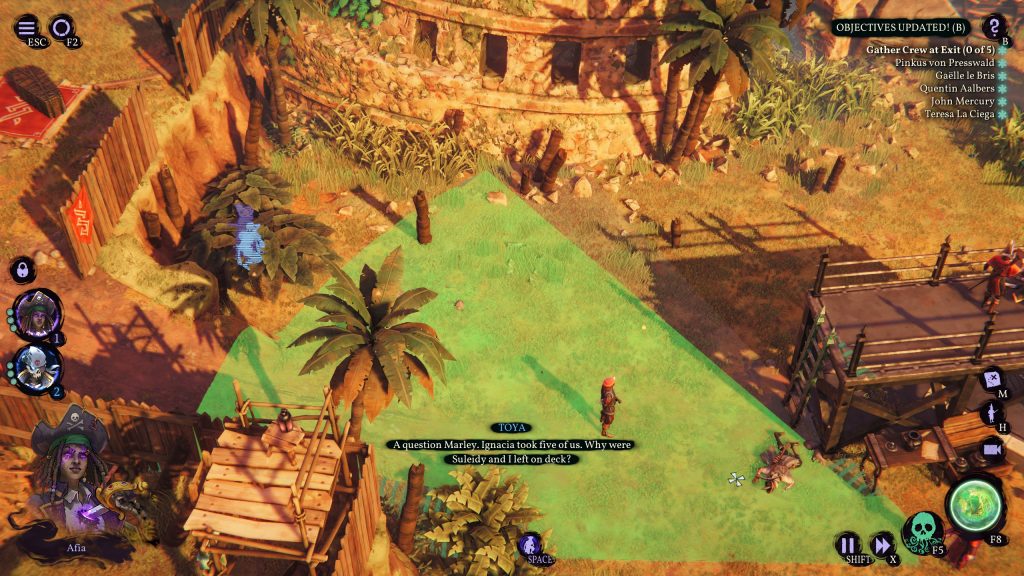
The Final Verdict
2023 has been an exceptional year for isometric tactical gaming experiences, and Shadow Gambit: The Cursed Crew more than deserves to be recognized, especially among the sea of more well-known triple AAA releases currently swarming the market.
With unique real-time, stealth-based strategy gameplay, a fun cast of characters and locales and an intriguing and spirited supernatural pirate story, this game is a must-play for fans of the genre and any gamer looking for something more cerebral in gameplay and colorful in narrative.
Game Details
Primary Format – Games – Microsoft Windows, PlayStation 5, Xbox Series X | S
Game Genre – Stealth strategy
Rating – M15+
Game Developer – Mimimi Games
Game Publisher – Mimimi Games


